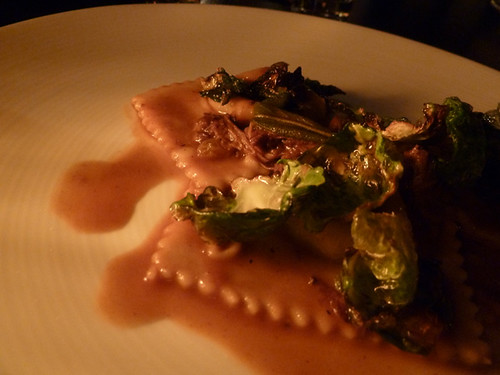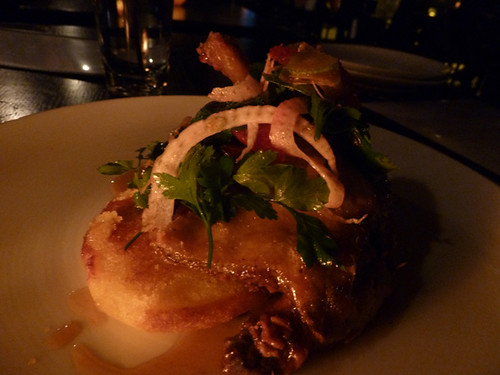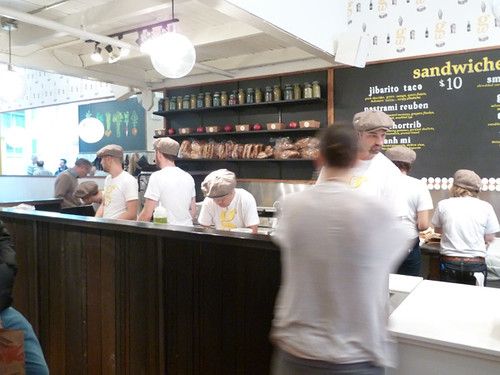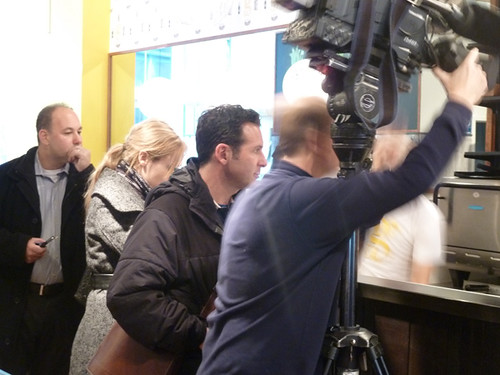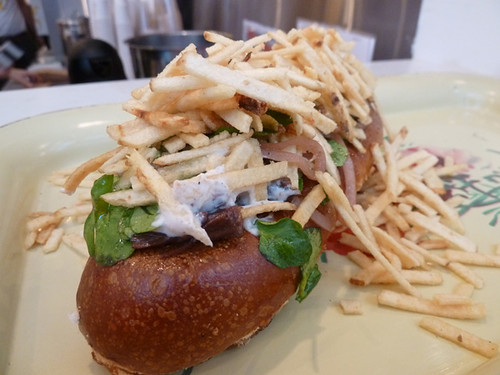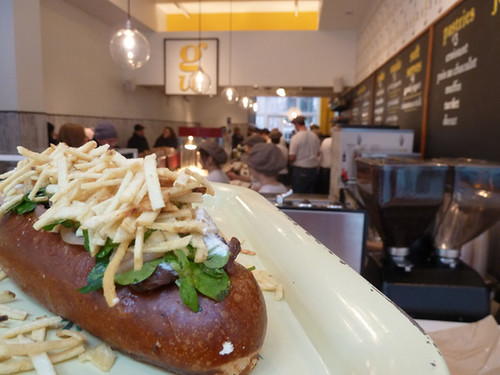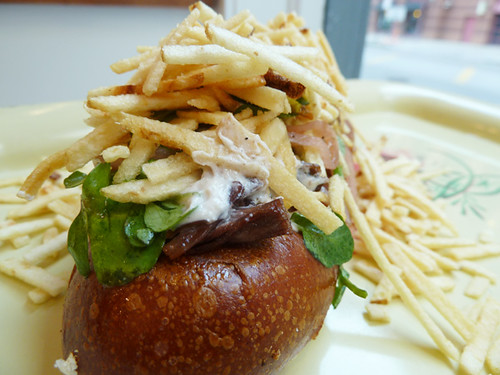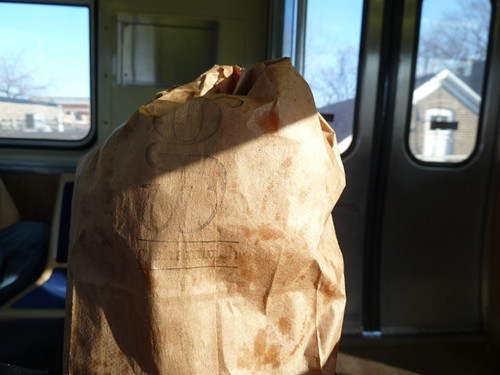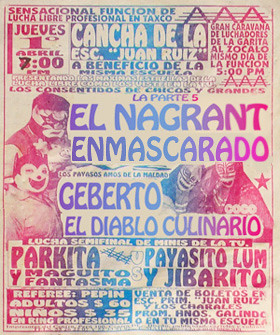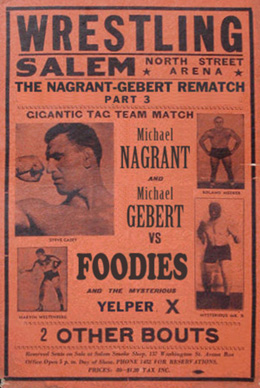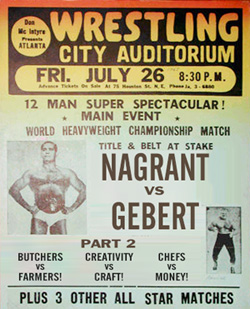For the second year in a row (see last year here, here, here, here and here), I’ve invited Michael Nagrant, food writer-bon vivant who hangs his hat at New City and Chicago Social among others, to kick around the past year in the Chicago food scene. We start this year’s discussion with a roundup of the year, but check back every day this week for whatever farflung topic we’ll have gotten to by then. And note a special feature this year: pose your questions for the rasslin’ reviewers in the comments, and one or both of us will have a crack at them on Friday.
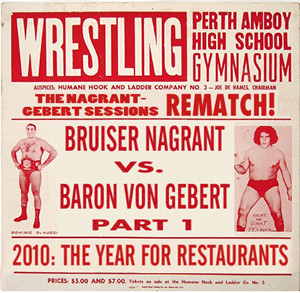
MICHAEL GEBERT: Welcome back, sir, you’re looking tanned, rested and ready. So what do you think about the year in restaurants? On the one hand, it seemed like the bad economy finally started to take its toll. On the other hand, at the present rate of increase, by the year 2028 every single person in Chicago will be opening a new restaurant using Slagel pork and Dietzler beef. How do you think 2010 was as a food year?
MICHAEL NAGRANT: Well, the Chinese Zodiac says the year of the Goat ain’t till 2015, but it sure felt that way. There was Izard and her drunken goats – great on her flat bread with kale by the way, great goat empanadas last night at Branch 27 from John Manion, the continued rise of Prairie Fruit Farms goat cheese.
Though I suppose goat is also like the “next Bob Dylan” phenomenon. Every year there’s some singer/songwriter who’s supposed to be the next Bob Dylan and they’re great and what not, but they’re never really going to displace the real Bob Dylan. Every year for the past five or something goat has been lauded as the next pork or whatever. Look at Bayless and his tireless promotion of the Kilgus Farm boys. In the end bacon is still king – and besides, Sky Full of Goat just doesn’t sound as sexy.
Still, this is of course just a long way of saying 2010 was the tipping point year for eating weird shit. I mean Lincoln Park trixies have always been into balls, but now they’re like, ohh, sweetbreads, yum-oh. I mean Fergus Henderson could now pull mad Keith Richard’s numbers of birds if he were to hang out at John Barleycorn on a Friday night.
I think that’s good – it means more places like City Provisions, Butcher and Larder, and Paul Kahan’s butcher concept will likely thrive because they can make a living beyond selling the filet.
And indeed if everyone is able to offer Slagel or Dietzler, then bravo, maybe we can just eat good food and not have to read about it on every inch of the menu. But of course what we know is that the small scale of such farms means not every restaurant can offer this stuff. A great aha moment for me (not to be confused with that other A-Ha moment of the Speed Racer clone “Take on Me” video) was talking to Bayless about the opening of Xoco and hearing about his desire to offer free-range pork, but having to settle for semi-free range, but sustainably raised pigs, from Maple Creek Farm because Gunthorp would have to ramp up production to meet demand and it would take a few years. Still, just as the demand creates more good restaurants, it may also create more local family farms, a bigger Green City Market etc and that’s cool by me.
The problem if there’s any this year which you do get at with your wry aside about all restaurants serving the same thing in 2028 is that indeed it does feel like the same restaurant opened up ten times this year. I mean what was the real outlier or the exciting genre breaker – Ruxbin? And if it was Ruxbin – is that just Schwa with a working phone?
I mean I can forgive Bon Appetit for naming Next or Aviary best new blah blah blah, because the fact is it probably will be. I applaud all the great craft cocktails, but all the cocktail talent we have still has its head stuck up the arse of 1919 while Grant Achatz is about to bend them over with what we should be drinking in 2015.
I think part of the blame is the blog war (and this includes old school pub blogs too – not just the new guys) we got going on. Everyone’s fighting for the last scrap and as a result they feel compelled to cover every two-bit line cook and his or her dream as if they were the next Thomas Keller. Mediocre falafel shacks in the suburbs are given the same pre-opening treatment/gossip as Grahamwich.
If you’re getting coverage by just aping everyone else, why would you ever have to be creative? The creativity once reserved for the plate is now showing up in the dining room instead. Chefs are spending as much or more time deciding which The Clash poster to put on the walls. Folks need to get back to the menu.
As for the economy taking its toll, I’d turn that back on you for more clarity. Who closed that shouldn’t have? I mean Pasticceria Natalina would be a big blow, but it didn’t close yet. I think maybe May Street Market and Aldino’s didn’t deserve to close. I don’t know if Aldino’s was the economy as much as it was an owner who didn’t give it a fighting chance.
GEBERT: Goat as Steve Forbert, I have to admit I hadn’t thought of it quite that way. Goat certainly seems trendy— though I hardly tasted it in the flurry of tiny bites that constituted dinner at Girl & The Goat recently, which was one of the disappointments looking back on that meal— but I always laugh when I see those “is pork over?” pieces, because to me it’s like saying “is tap water over?” Pork is one of the elements, it’ll be over when eating is over and the Matrix feeds us through a tube. I wish goat luck making some inroads as the next Dylan, I’m as interested as anybody to see what can be done with it, but pork is The Beatles. Which means you can now get it on iTunes, or something.
Anyway, I like your distillation of 2010 into “the tipping point year for weird shit,” and I think that’s very much true on the menu level— nobody seems to be afraid of anything any more. Pig face is flying off the racks at Girl & The Goat, and pork neck gravy is selling like hotcakes at The Purple Pig, and duck balls are moving at The Bristol, and bull testicles are a hot item on Phillip Foss’s truck. I was reading something somewhere (I honestly can’t remember where) about some dish that had veal heart in it, and one commenter said sorry, that’s where I draw the line, and I was like— really? You won’t eat a mere veal heart? The mere palpitating life-muscle of a tiny, innocent, doe-eyed veal? You draw the line at that? What’s wrong with you?
And maybe people have even absorbed the reality of food production enough now that they realize that they’ve actually been eating that stuff all along, only then it was called Oscar Mayer Luncheon Loaf or a Taco Bell Beef Gordita. But I also think there’s kind of a bigger shift that really became apparent in 2010, in the types of restaurants that made it in a big way, and the types of restaurants that bit the dust.
Last year, I thought the economy hadn’t really hurt the restaurant biz much— the places that closed seemed mostly to be the kinds of places that were ready to retire, like Healthy Foods in my video about it. But this year we’ve started to have some closings that surprised people, like May Street Market or Eve or Cafe Matou. Cafe Matou, to me, is the sort of place that you expected to just be around forever— not a great restaurant but a perfectly good neighborhood one, solid and grownup. Never had a bad meal there, you could take the ‘rents there and feel all sophisticated. Except it turns out being everybody’s old reliable fallback when they can’t get into hot new places isn’t enough to sustain a restaurant this year, or to sustain an older chef in working on his feet night after night for a much less full room. You don’t make any money being the second choice that doesn’t get used, funnily enough. And so we lose one of the last old school French restaurants on the north side.
Meanwhile, and I’m as guilty as the next north side hipster, they’re packing them in at Longman & Eagle. Which has an English name and a funky meats focus and a Belgian beer list and Charlie Poole or The 1900s on the playlist, and you can go eat some of 2010’s most exciting food in your jeans and your flannel shirt. And they get a Michelin star for it. Which was smart of the Michelin folks, not being as stodgy as they were assumed to be and getting out in the neighborhoods and finding where the real action is. Good for them.
But if the shift is big enough that even the French have to pay attention to it, it must mean something, which to me is that if the most exciting cuisine is moving not merely to kind of casually hip restaurants but outright bars, then what is the future for the middle of the road nice restaurant? If people today can get the level of cuisine with the atmosphere of a honky tonk and the beverages of a pub in Brussels, are they going to kiss off dressing up and sitting proper at a white tablecloth entirely? That certainly seems to have been the case with Aldino’s, which got its plug pulled as a standard Italian restaurant very quickly when U of I students didn’t come out for it, apparently, and was replaced by… I don’t know, Scott Harris opens Italian concepts too fast for me to remember. Something less like Spiaggia and more like a meatball bar or a shots-and-clams joint, anyway.
The high high end will survive, because that’s Disneyland, total escape and fantasy. But it’s going to get harder to be merely pretty good and merely kind of fancy and make it, if people are just a lot more comfortable in a bar where the dress, the music and the food are all funkier. That’s part of a big cultural shift away from behaving like grownups that if anything, the world of fine dining has been one of the last holdouts from (see David Brooks’ Bobos in Paradise for more), but it seems to have finally landed there, too.
NAGRANT: Cultural shift away from being grown-ups, huh? Well, it’s true Johnny Knoxville, smutty Peter Pan that he is, is the patron saint of a new generation. However, when it comes to dining, I don’t know that I agree or buy that the trend toward restaurants where you can dress how you want and eat what you want is a shift away from being grown-up.
I mean I subscribe to the theory that being grown-up means doing what you think is right or living how you believe you should live even if it’s against public opinion, which is not to say I believe R. Kelly should cavort with 14 year old girls.
But, as they say in Office Space, “The Nazis made the Jews wear flair.” Formal wear, especially say “black tie” is a construct of Saville Row tailors and a class-based differentiator promoted by aristocrats. People often dress up more as an expectation of others than as a choice. The fact that we’re now reclaiming that is pretty exciting to me.
In some ways this adherence to formality almost smacks of American insecurity, our only way to combat the vestigial guilt of having been the dirty rabble that escaped colonial rule. I mean go to Michel Bras or many Michelin 3 Stars in Europe and you’ll see people in jeans in a t-shirt. Does this make the experience any less valid?
Though I hate to side with Charlie Trotter on much, I do appreciate his Libertarian stance on stuff, i.e. I don’t like my actions to infringe on others and so maybe I’d draw the line at personal hygiene, i.e. if your body stink invades my adjoining table atmosphere and competes with the waft from my Epoisses, well then maybe I have an issue. However, if you are wearing a Chanel #5 spritzed burlap sack, it’s not gonna have any bearing on my enjoyment of dining out.
I think one of the most interesting things about Alinea is that they challenge most of what a restaurant should be, but they still prefer that their guests wear jackets. I don’t think they turn them away if they don’t, but why is it that one of the most innovative restaurants in America is so 1897 in their dress code policy? They’re smart enough to know that if they don’t enforce a basic standard, many of the patrons will be appalled or not return. It’s a business decision. Then again, they’re cool having a sommelier with a bedhead afro, so who knows what the line is. Then again, as I say, who cares?
GEBERT: Well, God knows I have many archaic tastes which will doubtless die with me, but one of them certainly is that it’s fun to dude up once in a while and be around other people who are dressed to the nines as well. Alinea wouldn’t be Alinea if everyone was in jeans, though personally I’d love it if one of Next’s concepts was futuristic and we all had to wear turtlenecks with capes like Raymond Massey in Things To Come or Ming the Merciless or somebody. That said, it does depress me a little when I’m surrounded by people who so obviously work on LaSalle (no offense to my wife, who’s just around the corner), charcoal gray with power ties and master of the universe self-seriousness, there is a distinct lack of a vibe when you’re in a room with people who have more money than God and seem joyless at spending it. All the same, what I’m spending there clearly hurts me a lot more than it hurts them, so they damn well better look nice while I’m eating there. They kind of owe it to me, really.
But dress is, really, just a minor part of what I’m talking about. There’s really a whole host of changes being made to the way we dine out— Belgian beer is the new wine, small plates have replaced the entree (on the whole, a big improvement in creativity, given how boring your protein and side dish shaped into a pyramid often proved to be compared to your apps), and everything from Harry Smith-style old-timey folk music to indie rock has replaced the video game soundtrack that seemed to be the only sound you heard while dining for most of the 90s and 2000s. That, at least, is my big story for 2010, that trend as validated by Michelin and every one else, it seems, and I don’t think it’s going to go away. I think anyone who follows the market would really have to think hard before opening a traditional restaurant, as opposed to a gastropub, a woodburning pizza oven place, a Bakersfield taco bar, or something else that offers comfier food with higher margins and a crowd that’s planning to knock back a few $9 brews at every meal.
NAGRANT: Don’t get me wrong, pocket watches, fedoras and vinyl records still have a place in my world (ok, well, not pocket watches). I mean I like to dress up too. I just don’t like it to be compulsory.
As for the elimination of traditional menu structure, well, again awesome. Ironically, this has its genesis in fine dining. The prix fixe menu (I guess some credit given to Spain too) is clearly the grandfather of what’s going on. So many of the chefs opening the informal places made their bones at Trotters, Tru, French Laundry, etc. However, only about 10 restaurants can live on that edge (I mean even Avenues shifted more to a la carte – hopefully the Michelin stars will allow them to shift the other way) and so what to do when you’ve made tiny courses most of your young career and you want to continue to do that? Well, make small plates of course. Also, it’s like Thomas Keller once said, and I’m paraphrasing here, the best sip of beer is the first cold one. After that the taste experience diminishes, the palate fatigues. Who needs 32 oz of ribeye when you can get 2 oz of Kobe, 2 oz of foie, 2 oz of king crab etc. So, maybe if this trend is indicative of something, maybe it’s our quick-cut movie-Twitter-impaired attention spans coming to roost in our eating habits. Then again, maybe skinny culture is ruling as well. Now all the dieters don’t have to take a bite and push away a meal and risk ridicule, or worse nosh a whole entree and feel like they’ve done the eating equivalent of a John Belushi drug bender.
Opening a super-fine dining spot is exactly where people probably need to go though if they want to stand out. I mean I think I gave Henri 3 stars out of 5 in CS this year, and that was primarily a function of the gorgeous dining room, the attentive service, and the general Robert Altman-worthy period piece like return to elegance. If the food had matched up (mostly quality control/execution issues, not the theory of the dishes), it would have slid in to four pretty easily. Which is funny, because I generally don’t care about non-food things. But, I do care about originality and what’s more original than pouring wine out of a magnum in a world of sour or hopped up beer flights?
TOMORROW: Chefs to fame like moths to flame?
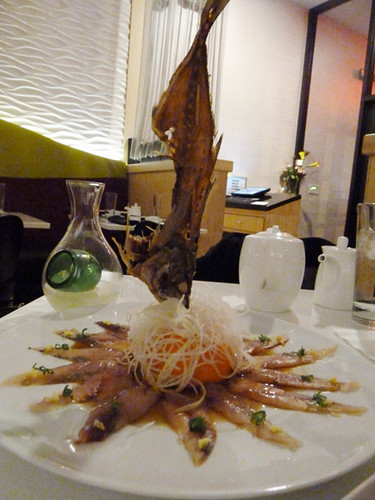
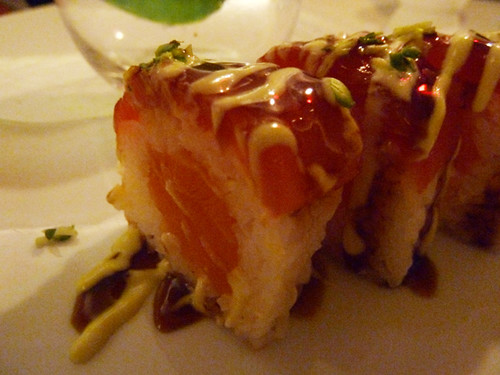
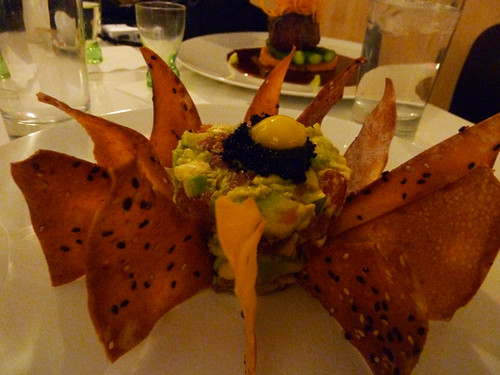


 Posted in
Posted in 

